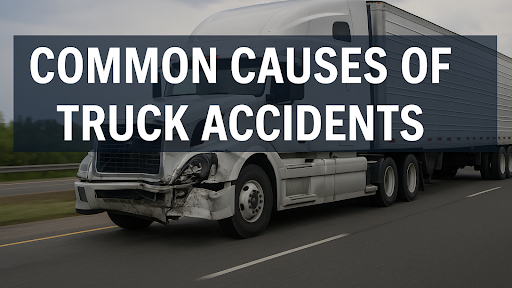Truck accidents can have devastating consequences, leading to severe injuries, costly damages, and legal complications. For truck drivers, fleet owners, and trucking companies, understanding the primary causes of these accidents is crucial for improving safety and compliance. This article examines the most common factors contributing to truck accidents, backed by verified data and industry insights.
1.Driver Fatigue
Fatigue is one of the leading causes of truck accidents. Federal regulations limit driving hours to 11 hours within a 14-hour workday, followed by a mandatory 10-hour rest period. However, some drivers violate these rules due to tight delivery schedules or financial pressures.
Fatigue impairs reaction time, decision-making, and focus, increasing the risk of collisions. According to the Federal Motor Carrier Safety Administration (FMCSA), drowsy driving contributes to approximately 13% of commercial truck accidents. Companies must enforce strict compliance with Hours of Service (HOS) regulations and encourage drivers to prioritize rest.
2.Improper Loading and Overweight Cargo
Improperly secured or overloaded cargo can shift during transit, causing loss of control or rollovers. Federal weight limits for commercial trucks are set at 80,000 pounds (including the truck and cargo), but some carriers exceed these limits to maximize profits.
Overloading strains braking systems, reduces tire traction, and makes steering more difficult. Additionally, unsecured cargo can spill onto the road, creating hazards for other motorists. Fleet managers must ensure proper weight distribution and securement before every trip.
3.Mechanical Failures
Truck breakdowns due to poor maintenance are a major safety concern. Common mechanical failures include:
- Brake failures (the leading mechanical cause of truck accidents)
- Tire blowouts (often due to worn tread or improper inflation)
- Faulty steering systems
- Suspension issues
The FMCSA requires pre-trip and post-trip inspections, but some drivers or companies skip these checks to save time. Regular maintenance and prompt repairs are non-negotiable for preventing accidents.
4.Distracted Driving
Distractions such as texting, GPS adjustments, eating, or fatigue-related inattention significantly increase accident risks. A study by the Large Truck Crash Causation Study (LTCCS) found that driver inattention was a critical factor in 14% of large truck crashes.
Trucking companies should implement strict no-phone policies and provide hands-free communication devices to minimize distractions.
5.Speeding and Aggressive Driving
Large trucks require longer stopping distances—up to 40% more than passenger vehicles. Speeding reduces a driver’s ability to react to sudden stops or obstacles. Aggressive behaviors like tailgating, erratic lane changes, and road rage further elevate risks.
Electronic Logging Devices (ELDs) and speed governors can help enforce safe driving practices.
6.Poor Weather Conditions
Rain, snow, ice, and fog reduce visibility and road traction. Trucks are especially vulnerable to jackknifing or hydroplaning in wet conditions. The U.S. Department of Transportation (DOT) reports that weather plays a role in about 23% of truck accidents.
Drivers should adjust speed, increase following distance, and avoid unnecessary travel during severe weather.
7.Lack of Proper Training
Inexperienced or poorly trained drivers are more likely to make critical errors. Key training areas include:
- Maneuvering large vehicles (blind spot awareness, turning radius)
- Emergency braking techniques
- Cargo securement protocols
Investing in comprehensive training programs reduces accident rates and improves compliance.
8.Drug and Alcohol Use
Despite strict DOT regulations, some drivers operate trucks under the influence. Alcohol, prescription drugs, and illegal substances impair judgment and coordination. Random drug testing and zero-tolerance policies are essential deterrents.
9.Inadequate Road Infrastructure
Poorly designed roads, narrow lanes, and insufficient signage contribute to truck accidents. Construction zones and sharp curves require extra caution. Drivers should plan routes in advance to avoid high-risk areas.
Conclusion
Understanding the causes of truck accidents helps drivers and companies implement preventive measures. Key strategies include enforcing HOS compliance, conducting thorough maintenance, improving driver training, and promoting distraction-free driving.
By prioritizing safety, the trucking industry can reduce accidents, protect lives, and maintain operational efficiency. Stay vigilant, adhere to regulations, and invest in long-term safety solutions to keep roads safer for everyone.
